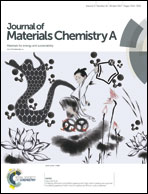Hydrothermal preparation of nitrogen, boron co-doped curved graphene nanoribbons with high dopant amounts for high-performance lithium sulfur battery cathodes†
Abstract
In this work, we for the first time synthesized nitrogen, boron co-doped curved graphene nanoribbons (NBCGNs) by a facile hydrothermal process using oxidized curved graphene nanoribbons (O-CGNs), urea and boric acid as the carbon precursor and heteroatom sources. The influence of N and B co-doping on the morphology, structure, composition and related electrochemical performance of the NBCGNs was systematically investigated, and the results show that urea and boric acid coexisting in the hydrothermal system not only act as the N and B doping sources but also act as the catalysts to boost the synergistical doping of N and B. It is the synergistical effect of N and B co-doping that endows the NBCGNs with enlarged specific surface area as well as pore volume, improved conductivity, promoted sulfur dispersibility and strengthened adsorbability for polysulfides caused by the notably increased doped N and B contents and higher percentage of the N–B structure when compared with the counterparts. As a result, the as-prepared NBCGN/S cathode presented synergistically enhanced cyclability and rate capability. Therefore, our results not only provide a superior carbon host for Li–S batteries but also offer a common approach to the preparation of heteroatom doped carbon nanomaterials with an optimized structure and composition.



 Please wait while we load your content...
Please wait while we load your content...